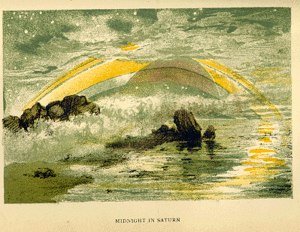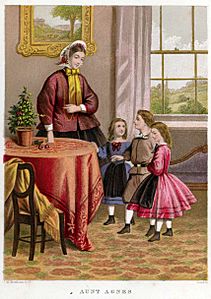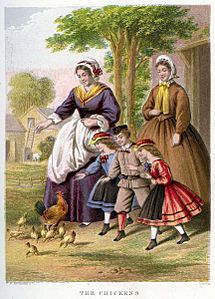Agnes Giberne facts for kids
Quick facts for kids
Agnes Giberne
|
|
|---|---|
| Born | 19 November 1845 Belgaum, Karnataka, India
|
| Died | 20 August 1939 (aged 93) Eastbourne, East Sussex, England
|
| Nationality | English |
| Other names | A. G. |
| Occupation | Writer and scientist |
| Years active | 1864–1930 |
| Known for | Popularising science and juvenile evangelical fiction |
|
Notable work
|
Sun, Moon, and Stars (1879) |

Agnes Giberne (born November 19, 1845, in Belgaum, India – died August 20, 1939, in Eastbourne, England) was a British writer. She wrote many novels and science books. Her stories for children often had moral or religious lessons. She also wrote historical novels and one well-known biography.
Agnes Giberne's Life Story
Agnes Giberne was born in Belgaum, India, on November 19, 1845. Her father, Charles Giberne, was a Captain in the Bengal Native Infantry. Her mother was Lydia Mary Wilson. Agnes's family came from Huguenots in France.
Agnes had several sisters, but sadly, some died when they were young. By 1861, only Agnes and her sister Eliza were still alive.
Agnes was taught at home by private teachers. She started writing stories when she was just seven years old. She said her mother helped her love reading and writing. Her father sparked her interest in science.
Becoming a Writer
Agnes Giberne began publishing children's stories when she was seventeen. Her first children's book, A Visit to Aunt Agnes, came out in 1864. She was 19 at the time. Her early children's books often taught lessons about good behavior and faith.
Here are some pictures from her book, A Visit to Aunt Agnes:
At first, Agnes used the initials A. G. or was just mentioned as "the author of other works." Her first book published under her full name was The Curate's House. This book aimed to show the struggles of poor church leaders. She also wrote books for older girls.
Agnes Giberne also wrote historical novels. These stories were set in different times in history, like:
- Detained in France (1871): About English people held captive by Napoleon.
- Aimée (1872): A story about the persecution of Huguenots in France.
- Coulyng Castle (1875): Shows life in a castle during the time of King Henry IV and Henry V.
- Roy (1901): Another story about people detained by Napoleon, including a famous battle.
- Under Puritan rule (1909): Focuses on Anglican clergy who lost their jobs during the Puritan era.
In 1895, Giberne wrote a biography called A Lady of England. It was about Charlotte Maria Tucker, another children's writer who later became a missionary in India.
Popularizing Science
Agnes Giberne is best known for her books that made science easy to understand. She was an amateur astronomer. This means she loved studying stars and planets as a hobby. She even helped start the British Astronomical Association in 1890. This group was for anyone interested in astronomy, especially women who couldn't join other societies.
Her first science book was Sun, Moon and Stars: Astronomy for Beginners (1879). A famous astronomy professor, Charles Pritchard, was so impressed that he wrote a positive introduction for it. People loved the book. One newspaper said it was "the best book of the kind we have seen." It sold thousands of copies and stayed popular for many years.
Agnes wrote other astronomy books, including:
- Among the Stars (1884): For younger children, explaining the solar system through a boy's adventures.
- The Starry Skies (1894): Explained gravity, seasons, and planets simply.
- Radiant Suns (1895): A more advanced book about astronomy history and the universe.
- This Wonderful Universe (1895, revised 1920): An introduction to the heavens for young readers.
She also wrote about other sciences:
- Geology: The World's Foundations (1882), explaining how the Earth was formed.
- Physics: Twilight Talks (1882), simple lessons about everyday things.
- Hydrology: Father Aldur (1887), a story about water.
- Meteorology: The Ocean of Air (1890), explaining weather and the atmosphere.
- Natural History: A Modern Puck (1898), a fairy tale with facts about animals and insects.
- Oceanography: The Mighty Deep (1902), about the oceans.
- General Science: This Wonder World (1913), covering topics like wood, iron, coal, and flying machines.
- Botany: The Garden of Earth (1920), about plant life and growth.
Agnes Giberne wrote a huge number of books. She was most active in the 1880s and 1890s, publishing many volumes each decade. Her dedication to writing was clear throughout her long career.
| Decade | Number |
|---|---|
| 1860–1869 | 12 |
| 1870–1879 | 26 |
| 1880–1889 | 36 |
| 1890–1899 | 33 |
| 1900–1909 | 11 |
| 1910–1919 | 7 |
| 1920–1929 | 4 |
| 1930–1939 | 1 |
Later Life
Even though Agnes Giberne wrote because she loved it, she also relied on the money from her books. In 1905, she faced financial difficulties. She was 60 years old and had spent many years caring for her sick father. She also had problems with her eyesight and heart. She received some money from literary funds to help her.
In 1911, she was living in Eastbourne. She passed away in a nursing home in Eastbourne on August 20, 1939, at the age of 94.
See also
 In Spanish: Agnes Giberne para niños
In Spanish: Agnes Giberne para niños





